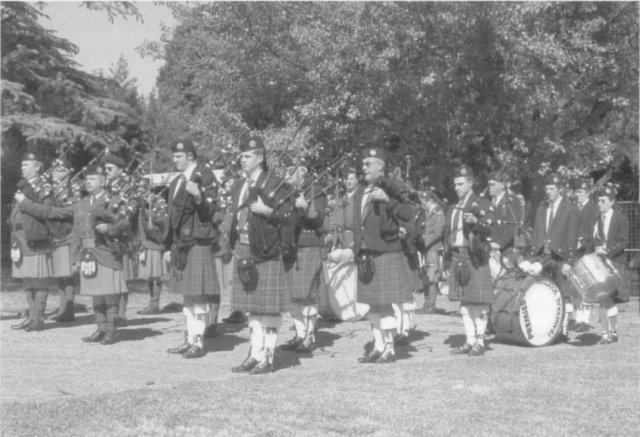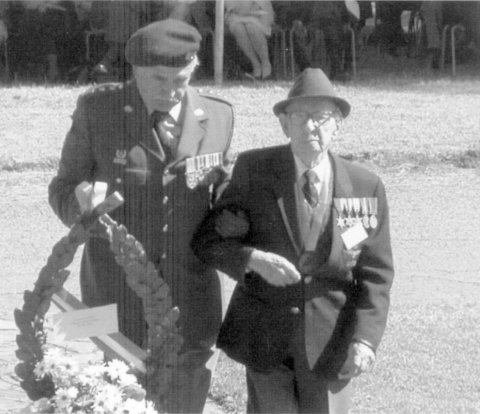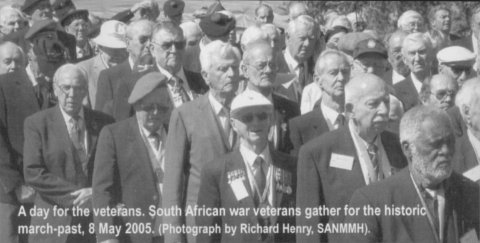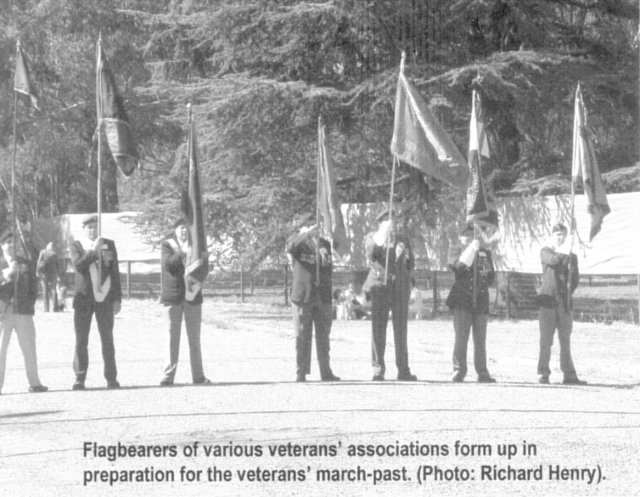

 The South African
The South African
Sunday, 8 May 2005, saw the 60th anniversary of VE Day, the day when Winston Churchill, wartime prime minister of the United Kingdom, broadcast through the BBC the news that the Allies had achieved victory in Europe after five-and-a-half long years of warfare. The anniversary was commemorated throughout the Commonwealth of Nations and South Africa was no exception. Formal commemorative services were planned for the three major centres of this country - Johannesburg, Cape Town and Durban. This article will focus on the Johannesburg event organised at the South African National Museum of Military History and the adjacent Rand Regiments Memorial. This event also served as the Museum's main contribution to International Museum Day, which is celebrated annually on or around 18 May.
Before discussing the event held this year on 8 May, one needs to go back sixty years and find out what people were doing on VE Day in 1945. Freddie Nkomo, who works at the entrance desk of the Museum on weekends and served with the Union Defence Forces (UDF) in North Africa, told us that he was in Cairo at the time. He remembers vividly that the celebrations and parties went on for a week after 8 May. Lionel Roche, a former Trustee of the Museum who served in the South African Artillery, was in New York and made an official broadcast on United States radio on behalf of the Union Defence Forces (UDF) (SABC TV interview, 8 May 2005).
Most members of the UDF were serving in Italy at the end of the war. The main fighting formation of the UDF at that time was the 6th South African Armoured Division, which was concentrated in the Milan area when the German forces in Italy surrendered on 2 May 1945. Orpen (1975, pp 308-9) writes that, after having fought so long against so resolute an enemy, the Division now had the eerie experience of having to watch the Germans, even then well disciplined and controlled by their own military police, moving past them on their way to the surrender point. On 4 May, a Divisional parade was held at Brughera, north-east of Milan. After addressing the troops, Maj Gen W H E Poole, the General Officer Commanding 6th SA Armoured Division, unfurled a Union flag which had been presented to him to be broken only once victory had been achieved. In the dexter quadrant was the green and gold flash of the Division and on the flag were the signatures of Field Marshal J C Smuts, Prime Minister and Commander-in-Chief of the UDF, and Lt Gen Sir H A van Ryneveld, Chief of the South African General Staff. The final victory celebration for the Division took place at Monza on 14 May 1945, when Field Marshal Sir Harold Alexander, Commander-in-Chief of all Allied forces in the Mediterranean, and Gen Mark Clark, Commanderin-Chief of the 15th Army Group, took the salute as the South Africans marched past on the famous racing track.
Of course, there were many other South African formations and units operating in other parts of the Mediterranean and Europe at the time. These included the large number of South African Engineer Corps units which undertook sterling work in both the Middle East and Italy, and the South African Air Force, which had grown into a service of around 35 operational squadrons by the final year of the war. The South African Naval Forces had also developed into a fighting force well beyond any capability imagined at the beginning of the war. In all, Martin and Orpen (1979, p 347) state that a total of 342 692 South African men and women of all races volunteered for service between September 1939 and September 1945. Of these, 38 208 were listed as casualties.

Sixty years later, with the anniversary of VE Day looming, the Military Associations of Gauteng (MAG) met and decided to put together a commemorative service and luncheon for as many Second World War veterans as possible. MAG is a committee representing all the Gauteng-based regimental and unit associations of the Reserve Forces (formerly the Active Citizen Force) of the South African National Defence Force (SANDF). The general feeling was that, because most veterans are now in their 80s and 90s, this would be the last major occasion commemorating the Second World War where so many veterans could be brought together at one time.
MAG then approached the SA National Museum of Military History to look at the feasibility of hosting the event. The Museum did not hesitate for the following reasons. Firstly, when Smuts officially opened the Museum in August 1947, he referred to it as a memorial to what he termed ' ... the greatest united effort our country had been called upon to produce ... ' (Opening Speech, 29 August 1947). Secondly, the Museum has come to be regarded as a symbolic home for veterans in South Africa and throughout the world. A number of veterans' organisations view the Museum as their headquarters. It therefore stood to reason that this event should take place at the Museum. Thirdly, it was fortuitous that the event would take place very close to this year's International Museum Day (18 May), the theme of which is 'Museums Bridging Communities'. Bearing in mind the close association between the Museum and the war veteran community, it felt right to market this event as the Museum's main contribution towards this year's International Museum Day.
The initial plan (Minutes, MAG SubCommittee Meeting, 24 February 2005) was to hold a small wreath-laying service in the Dan Pienaar Gun Park, named after the famous South African general who led both the 1st South African Brigade and 1st South African Division during the campaigns in East and North Africa in 1941/1942. This service would be followed by a formal luncheon in the new, recentlycompleted Armoured Car Hall near the new Museum Entrance.

On 7 February 2005, however, the Military Council of the SANDF approved the organisation of "three official functions to be held in Johannesburg, Cape Town and Durban respectively. The Headquarters of 46 Brigade in Kensington was chosen as the initial venue for the Johannesburg function. This posed a number of problems for MAG, as the target audience was identical for both events. The envisaged guest speakers for the Museum event were also to be invited to the official function at 46 Brigade. MAG was therefore faced with three alternatives:
Firstly, the planning of the Museum event could be adapted to allow for the late arrival of the guest speakers. Secondly, a request could be made that the official SANDF function be delayed to the late afternoon. Thirdly, steps could be taken to request the combination of the two events. This would mean that the official SANDF parade would be held at the Rand Regiments Memorial outside the Museum (Minutes, MAG Sub-Committee Meeting, 23 March 2005).
Fortunately, the SANDF (Ceremonial Instruction 12/2005, Department of Defence, Human Resources Support, Ref: HR SUP CEN/CER/R/512/2/1) had made provision for the Johannesburg commemoration service to be moved to the Rand Regiments Memorial if required and, eventually, it was officially agreed that the venue would be changed. MAG then proposed that the Welsh Male Voice Choir of South Africa be invited to perform during the service and that a marchpast of Second World War veterans, led by the massed pipes and drums of the Transvaal Scottish and South African Irish, be included at the end of the programme (Minutes, MAG Sub-Committee, 30 March 2005). In the meantime, preparations at the Museum were well underway and all the vehicles on display in the new Armoured Car Hall were moved out during the week prior to the event. The South African Mk I and Mk III Armoured Reconnaissance Cars, used during the East and North African campaigns, were placed on display in the north vista of the Memorial, where the veterans' registration tent was to be located. Owing to the careful planning and several rehearsals of the event, the 60th Anniversary of VE Day went off without any hitches on 8 May. Approximately 650 people attended the commemorative service. Of these, around 400 were Second World War veterans of every race and gender. Each veteran who registered through MAG received a commemorative medallion.

The event took the form of a Remembrance Day Service as observed on 11 November. The Master of Ceremonies was Maj Ian Crowther of the Transvaal Scottish, also a member of the Advisory Board of the SA National Museum of Military History. Eight sentries, each carrying the same rank and wearing traditional, regimental dress, took post around the Memorial in two shifts of four sentries each. They were provided by the Transvaal Scottish, Witwatersrand Rifles, Rand Light Infantry and Johannesburg Regiment. The service was conducted by Chaplain T Ngombane of the South African Military Health Services and by the Rev David Jones of the Transvaal Scottish. After the Two-Minute Silence, held between the Last Post and Reveille, there was a flypast of Caravan aircraft from 41 Squadron, South African Air Force. This flypast observed the Missing Man formation where one aircraft detaches itself from the formation in respect of those who died in battle.
Wreaths were then laid by, amongst others, Lt Gen P T Matanzima on behalf of the Chief of the SANDF, Mr Tokyo Sexwale on behalf of the Reserve Force Council, Brig David Keenan, the British Military Adviser, on behalf of the British Armed Forces, and Mr M Finberg, a veteran aged 93, on behalf of all those who had served in the war. Before laying a wreath, a veteran was informed that the pathway up to the Memorial was uneven and a little tricky to negotiate. 'So were the battlefields', was his reply. During the wreath-laying, Pipe Major Craig Herwell of the South African Irish played the traditional lament and 'Flowers of the Forrest'.
The Welsh Male Voice Choir of South Africa presented a programme of appropriate songs throughout the service. The music played and all songs performed had a military connection. The Choir also provided choral leadership during the singing of the hymn, 'Oh God Our Help in Ages Past' and the National Anthem.
After the service, all the veterans were ordered to fall in for the march past. As they formed up, the Choir sang a stirring 'Lest we Forget'. The march past was led by flag-bearers of all the associations represented in MAG and the eight sentries, followed by veterans in wheel chairs. Those unableto march stood to one side for the duration of the march. This was a most moving and historic occasion.
Thereafter, the proceedings moved into the Museum, where the MAG luncheon and the official SANDF reception were held in the new Armour Hall and the Dan Pienaar Gun Park respectively. Visitors also made use of picnic facilities available in the Museum grounds, or purchased lunches at the Vargas Cafe located on the premises. Bar facilities were provided by both the Transvaal Scottish and the Johannesburg Regiment.
The MAG luncheon was attended by 432 people and the official toasts were given by Maj Gen Roy Andersen, Chief of Defence Force Reserves and a member of the Museum's Advisory Committee, and Brig Keenan, who also read out an official message from Queen Elizabeth II as head ofthe Commonwealth of Nations. The microphone was then passed around to various veterans to enable them to introduce themselves and to tell their stories on an informal basis. The lunch was concluded with a cabaret presented by the well-known celebrity, Bob Courtney, himself a Second World War veteran.
The event was made possible through a number of generous sponsorships. Sponsors included Mr Tokyo Sexwale (funding), Pick 'n Pay (grocery vouchers for the veterans), the Oppenheimer family (table wine and a bottle of port with an official VE Day MAG label for each veteran), Nestle (chocolate for the ladies), Aveng and Duro Pressings and the Reserve Force Council (commemorative medallions and coffee mugs) (Minutes, MAG Sub-Committee Meeting, 28 April 2005).
In reflection, one might be tempted to ask why such an event was necessary and why the Museum played the part that it did. The purpose of the national 'War Museum' is not to glorify war or to merely boast about South Africa's military prowess. If there is anything positive to draw out of South Africa's experience in both world wars, it is that compatriots were able to put aside their differences and serve together in sufficient numbers to make a meaningful contribution towards ending world domination by dictatorships. Men and women who volunteered and served in the Second World War often refer to the sense of unity and of a common purpose which their service stimulated, not only amongst South Africans, but amongst like-minded people all over the world. It is important that South Africans acknowledge and remember their history and their brothers and sisters who laid aside their differences and sometimes even their lives in a struggle which they believed would create a better world for us all (Blendulf, 2004). The event of 8 May 2005 was a historic occasion for the specific reason that we will never again witness such a sight on such a commemorative occasion for the Second World War. This is an unfortunate reality of life.

Sources
Personal correspondence, Mr F Nkomo, SA National Museum of Military History, 16 April 2005.
SABC TV Interview, Mr L Roche, SA National Musuem of Military History,8 May 2005.
Orpen, N, Victory in Italy (Purnell, Cape Town, 1975).
Martin, H J and Orpen, N, South Africa at War (Purnell, Cape Town, 1979).
Official opening speech by Prime Minister Field Marshall J C Smuts at the South African National War Museum, 29 August 1947.
Military Association of Gauteng (MAG), Minutes of Sub-committee meetings held to plan and co-ordinate the event, February to May 2005.
SANDF Ceremonial Instruction 12/2005, (Department of Defence, Human Resources Support, Ref: HR SUP CEN/CER/R/512/2/1).
S Blendulf, 'Reconciliation and Nation-building: South Africa at War', (unpublished Reconciliation Day pamphlet produced by the South African national Museum of Military History in association with the Freedom Park Trust, 18 December 2004).
Return to Journal Index OR Society's Home page
South African Military History Society / scribe@samilitaryhistory.org